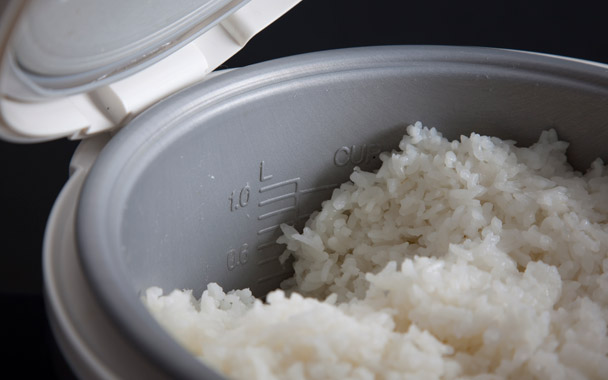Rice cookers used to be simple: They made rice. The good ones made it well, and they were relatively inexpensive. End of story. Today, there are still plenty of affordable models on the market, but you can also find fancy versions (costing up to $500) that have settings for different kinds of rice and perform double-duty as pressure cookers. According to some manufacturers, you can make flan, a cake, or an entire dinner in a rice cooker.
I don’t really see the virtue in baking desserts or sautéing onions in a rice cooker, but I do really appreciate the different settings: Brown and white rice require slightly different cooking times and amounts of water, and one of the three cookers I’ve worked with (a Zojirushi’s pricey “Induction heating system and rice cooker and warmer”) works wonders with the brown, producing a much softer grain than most, and just the right amount of chew. And the pressure-cooker models are definitely appealing, since they allow you to make rice and beans in one shot. I’ve prepared plenty of one-pot meals in the rice cooker for very little money and effort. And in small kitchens—like my own in Beijing, where standard stoves have only two burners—rice cookers are a must.
To make one of my favorite weeknight dinners, I marinate a few meaty pork ribs (halved crosswise) in a mixture of soy sauce, sesame oil, oyster sauce, and a splash of rice wine; meanwhile, I measure brown rice and water into the pot. I add the ribs and marinade on top of the uncooked rice, then set the machine to brown-rice mode. The result is rich, flavorful rice and fork-tender ribs; a sprinkle of cilantro or chopped scallions and dinner’s ready, for just a couple of bucks, with an active time of five minutes.
Another good dinner option is quinoa, the perfect grain. I use the same ratio of grain to water as I do with white rice, and the quinoa is great every time. Try quinoa wherever you’d use couscous, such as in this quick Moroccan stew.
After I’m done with dinner, I often wash out the rice cooker and throw in my power-breakfast ingredients of rolled oats, goji berries, raisins, walnuts, Chinese dates, and sesame and flax seeds, setting the timer for the next day. Hearty oatmeal greets me in the morning at a temperature good enough for Goldilocks.
For a light Chinese meal (such as congee, jook, or zhou), add any type of rice and ten (yes ten) times the amount of water to yield a basic version. Add dried mushrooms or scallops for intense flavor and use broth instead of water for the ultimate Asian comfort food.
I’ve even used my rice cooker for perfect stir-free polenta—leaving me plenty of time to do other things like sauté mushrooms and grate a little cheese to go on top. A ratio of 1 cup coarse polenta to 4 cups water, cooked on white-rice mode, makes an easy, hassle-free supper or starter. The cooker keeps it hot and prevents it from getting too thick until I’m ready to serve it. Rice-cooker polenta is like manna from the heavens when I’m single-handedly hosting a multi-course dinner party.
Of course, my rice cooker also makes a mean pot of rice.




 Pinterest
Pinterest


